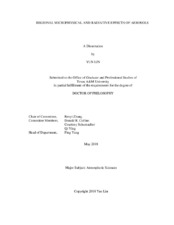| dc.contributor.advisor | Zhang, Renyi | |
| dc.creator | Lin, Yun | |
| dc.date.accessioned | 2019-01-17T18:10:09Z | |
| dc.date.available | 2020-05-01T06:23:58Z | |
| dc.date.created | 2018-05 | |
| dc.date.issued | 2018-05-05 | |
| dc.date.submitted | May 2018 | |
| dc.identifier.uri | https://hdl.handle.net/1969.1/173471 | |
| dc.description.abstract | In this study, the regional-scale aerosol effects are quantitatively assessed under various weather conditions by conducting numerical modeling studies to improve the understanding of physical processes involved in aerosol-cloud and aerosol-radiation interactions.
A continental cloud complex consisting of three cloud regimes is simulated by the Weather Research and Forecast (WRF) model to investigate the aerosol microphysical effect (AME) and aerosol radiative effect (ARE). The results reveal that the responses of three cloud regimes to aerosols are jointly controlled by AME and ARE. The aerosol effects on the cloud complex are distinct from its individual cloud regime, highlighting that aerosol-cloud interactions for diverse cloud regimes and their transitions need to be carefully evaluated.
The increasingly severe regional haze in China is associated with a high ratio of oxygenated organic aerosol over odd-oxygen concentrations during clean-to-hazy transition periods, corresponding to intensive photochemical activities in Beijing. Modeling studies using WRF with an aerosol radiative module indicate that the aerosol-planetary boundary layer interactions during severe haze might trigger a positive feedback loop to amplify PM pollution. The small negative forcing at top of atmosphere (TOA) by the heavy loading PM is a result of the strong cooling largely canceled out by the strong heating. The aging of black carbon can contribute significantly to the total PBL collapse and the total BC TOA forcing.
The impacts of aerosols on a hurricane with ocean coupling is studied by using the WRF coupled with Regional Ocean Model System. The aerosol effect causes an expansion of storm circulation at the cost of the intensity. The aerosol-induced feedback of ocean coupling shows an appreciable influence on the mature storm. The storm destructiveness tends to be exacerbated by the aerosol effect due to the circulation expansion and corresponding structure modulations under polluted condition. | en |
| dc.format.mimetype | application/pdf | |
| dc.language.iso | en | |
| dc.subject | Aerosols | en |
| dc.subject | Cloud | en |
| dc.subject | Microphysical effect | en |
| dc.subject | Radiative effect | en |
| dc.subject | Haze | en |
| dc.subject | hurricane | en |
| dc.subject | Ocean coupling | en |
| dc.title | Regional Microphysical and Radiative Effects of Aerosols | en |
| dc.type | Thesis | en |
| thesis.degree.department | Atmospheric Sciences | en |
| thesis.degree.discipline | Atmospheric Sciences | en |
| thesis.degree.grantor | Texas A & M University | en |
| thesis.degree.name | Doctor of Philosophy | en |
| thesis.degree.level | Doctoral | en |
| dc.contributor.committeeMember | Collins, Donald | |
| dc.contributor.committeeMember | Schumacher, Courtney | |
| dc.contributor.committeeMember | Ying, Qing | |
| dc.type.material | text | en |
| dc.date.updated | 2019-01-17T18:10:09Z | |
| local.embargo.terms | 2020-05-01 | |
| local.etdauthor.orcid | 0000-0001-8222-0346 | |


